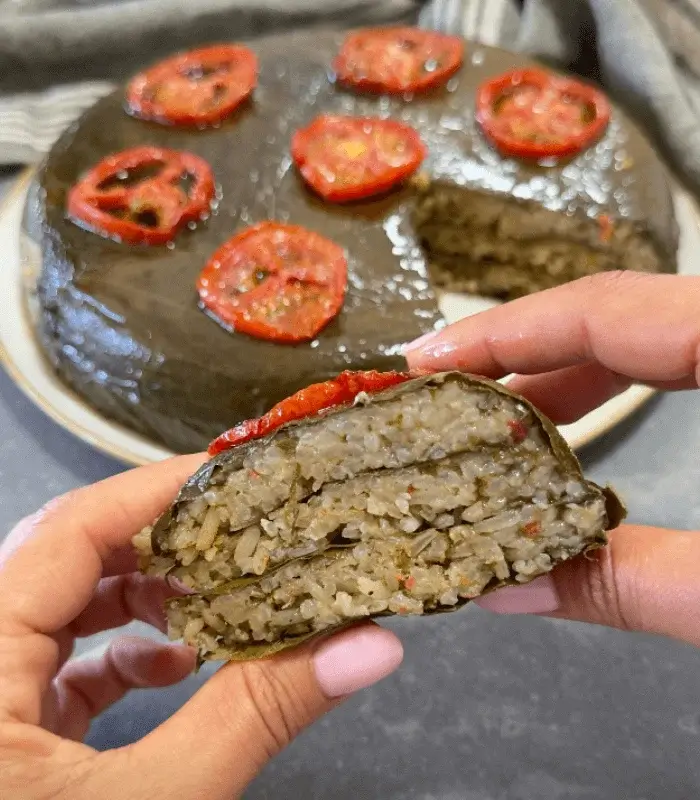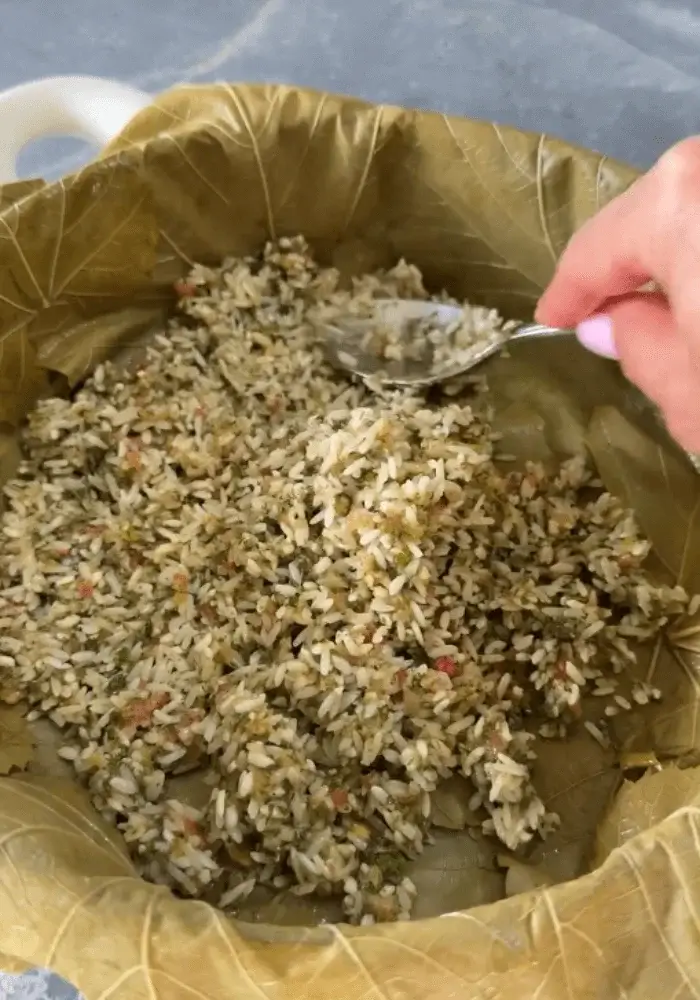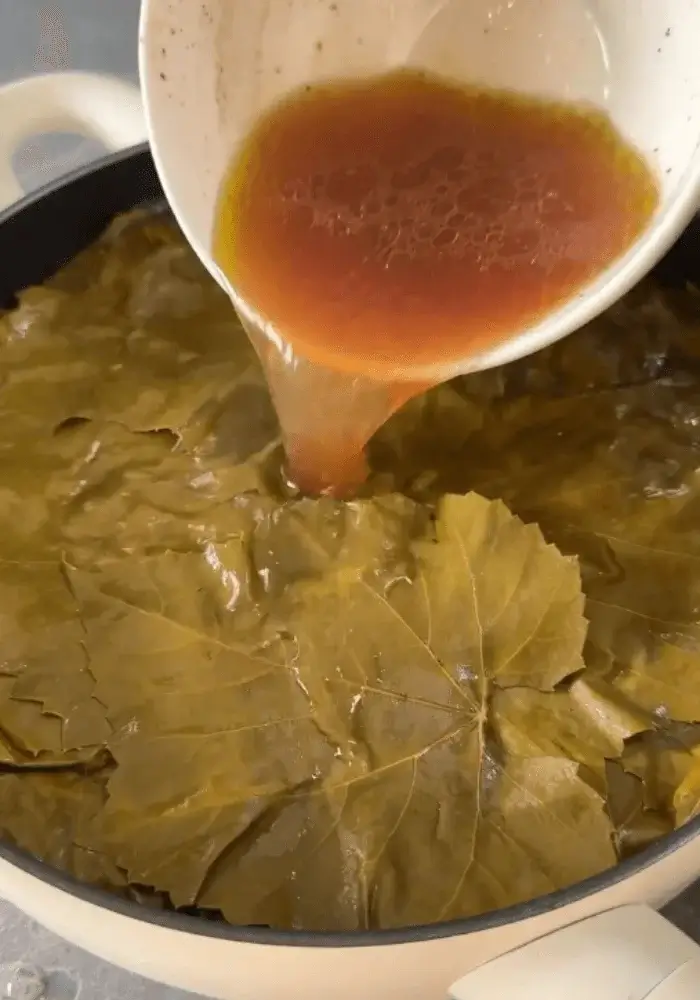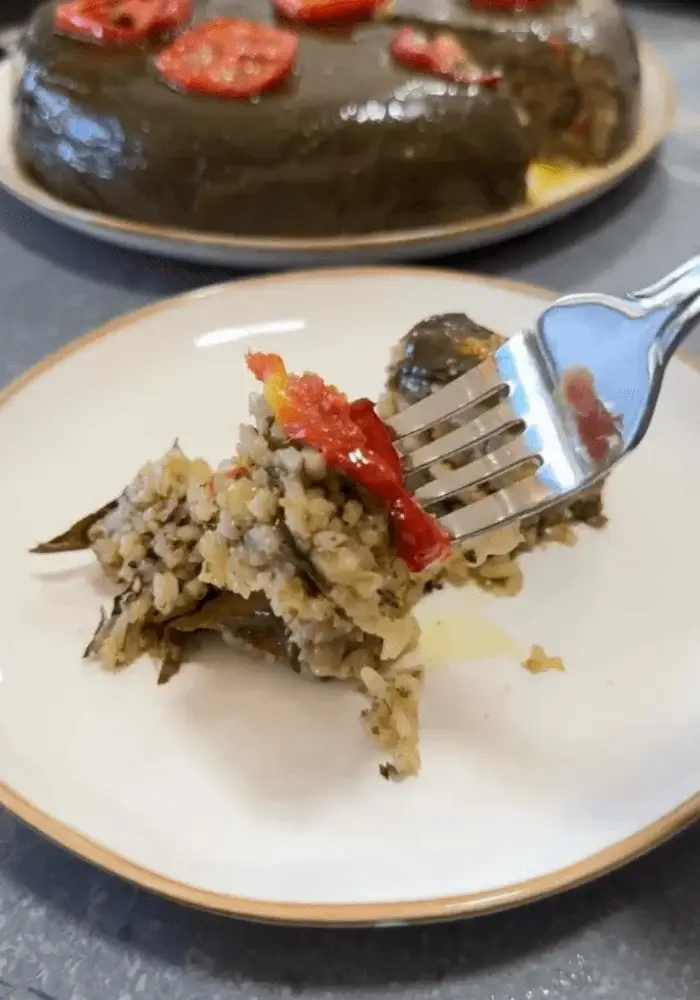Stuffed Grape Leaf Torte
We may earn a commission from recommended products, at no extra cost to you. See Disclosure.
INGREDIENTS
- 3 cups short-grain rice
- Fresh or jarred grape leaves, enough for layering
- 2 peeled tomatoes
- 1 large onion
- 4 peeled garlic cloves
- 1 handful parsley
- 1 handful dill
- 1 handful mint
- 1 handful cilantro
- 3 tablespoons olive oil
- 1 teaspoon black pepper
- 1 tablespoon salt
- Juice of ½ lemon
Sauce:
- 3 tablespoons date syrup or pomegranate molasses
- Juice of 2 lemons
- ¼ cup olive oil
- 1 teaspoon salt
- ½ teaspoon black pepper
- 2 cups boiling water
INSTRUCTIONS
- In a food processor, finely chop the tomatoes, onion, garlic, parsley, dill, mint, and cilantro. Transfer to a large bowl and mix with the rice, olive oil, salt, pepper, and lemon juice until fully combined. If using fresh grape leaves, blanch them in boiling water for 5 minutes. Drain well and let cool to room temperature.
- Line the bottom and sides of a large nonstick pot with grape leaves, overlapping them slightly.
- Spoon in a layer of the rice mixture, smoothing it out evenly. Cover with another layer of grape leaves. Repeat the layering, alternating rice and leaves, finishing with a final grape leaf layer on top. Use a skewer or toothpick to poke a few holes down through the layers so the sauce can absorb evenly.
- In a small bowl, mix together the date syrup or pomegranate molasses, lemon juice, olive oil, salt, pepper, and boiling water. Pour some of the sauce over the layers between each addition, and pour the remaining sauce on top once the cake is fully layered.
- Place a sheet of parchment paper directly on the top grape leaves, then press a heatproof plate over it to weigh it down. Cover with a lid and cook over low heat for 30 minutes.
- Transfer the pot to a preheated 340°F (170°C) oven and bake for 1 hour.
- Remove from the oven and let rest for 15 minutes. Invert onto a serving platter, garnish with roasted tomatoes if desired, and serve warm.

FAQ
How to layer rice and leaves in a stuffed grape leaf torte
To layer a stuffed grape leaf torte properly, start by lining the bottom and sides of a nonstick or heavy-bottomed pot with grape leaves, making sure they overlap and extend slightly up the sides to help contain the filling. Add a layer of seasoned rice mixture and spread it evenly, then cover with another layer of grape leaves. Continue alternating rice and grape leaves, finishing with a top layer of leaves that fold inward to seal the cake. Press gently between each layer to compact the structure. Use a skewer to create holes for the braising liquid to seep through.

Can I use brown rice instead?
Brown rice can be used in a stuffed grape leaf recipe, but it requires adjustments. Unlike white short-grain rice, brown rice takes longer to cook and absorbs more liquid. To ensure even cooking in a stuffed grape leaf torte, it’s best to parboil the brown rice until slightly tender before mixing it with herbs and aromatics. Keep in mind that brown rice has a nuttier flavor and firmer texture, which will change the final mouthfeel of the dish. You may also need to increase the amount of braising liquid and extend the cooking time to prevent undercooked grains.
How do I keep the stuffed grape leaf layers from falling apart?
To prevent the layers of a stuffed grape leaf torte from falling apart during unmolding, it’s essential to pack the rice mixture tightly and use overlapping grape leaves to create a stable structure. The top layer of grape leaves should be folded inward to seal the torte completely, helping it maintain shape. Weighing the torte down with a plate during cooking adds compactness. After baking, let the dish rest for at least 15 minutes before inverting it onto a serving plate. Resting helps the structure firm up as the rice settles, reducing the chance of breaking when unmolded.
What herbs work best in a stuffed grape leaf torte?
The most effective herbs for a stuffed grape leaf rice cake are parsley, dill, mint, and cilantro. These herbs provide a traditional Mediterranean flavor profile that complements the rice and grape leaves. Parsley adds freshness, dill brings a slightly tangy note, mint adds brightness, and cilantro contributes a complex, slightly citrusy flavor. All herbs should be used in balance and finely chopped to blend evenly with the rice. Fresh herbs are strongly preferred over dried, as they contribute both aroma and texture to the dish. Including a mix of these four herbs gives the rice a layered, vibrant taste.

Can I make a stuffed grape leaf torte ahead of time?
You can make this stuffed grape leaf torte in advance. After cooking and baking the dish, allow it to cool completely before covering and refrigerating. It can be stored in the fridge for up to three days. To serve, gently reheat it in the oven covered with foil at 300°F (150°C) until warmed through. Alternatively, you can prepare the torte up to the point of baking, refrigerate it unbaked for up to 24 hours, and then bake it when ready. In either case, resting time helps the flavors develop and the structure stabilize for easier unmolding.
Can I freeze this stuffed grape leaf torte after baking?
Yes, a stuffed grape leaf torte can be frozen after baking, but there are important considerations. First, allow the torte to cool completely. Then wrap it tightly in plastic wrap and foil to prevent freezer burn. It can be frozen for up to 2 months. To reheat, thaw it overnight in the refrigerator and then bake at 325°F (160°C), covered, until fully heated through. The texture of the grape leaves may become softer and slightly darker after freezing, but the flavor will remain intact. For best results, freeze individual portions to allow faster and more even reheating.
How do I prevent the bottom from burning?
To prevent the bottom of a stuffed grape leaf cake from burning, line the base of the pot with an extra layer of grape leaves before adding the rice filling. These leaves act as a protective barrier. Using a thick-bottomed or nonstick pot helps distribute heat more evenly. Cooking over low heat during the stovetop phase also reduces the risk of scorching. When transferring the dish to the oven, maintain a moderate temperature of 340°F (170°C) and keep it covered to trap steam. If the leaves at the bottom do darken slightly, they can be removed before serving.

